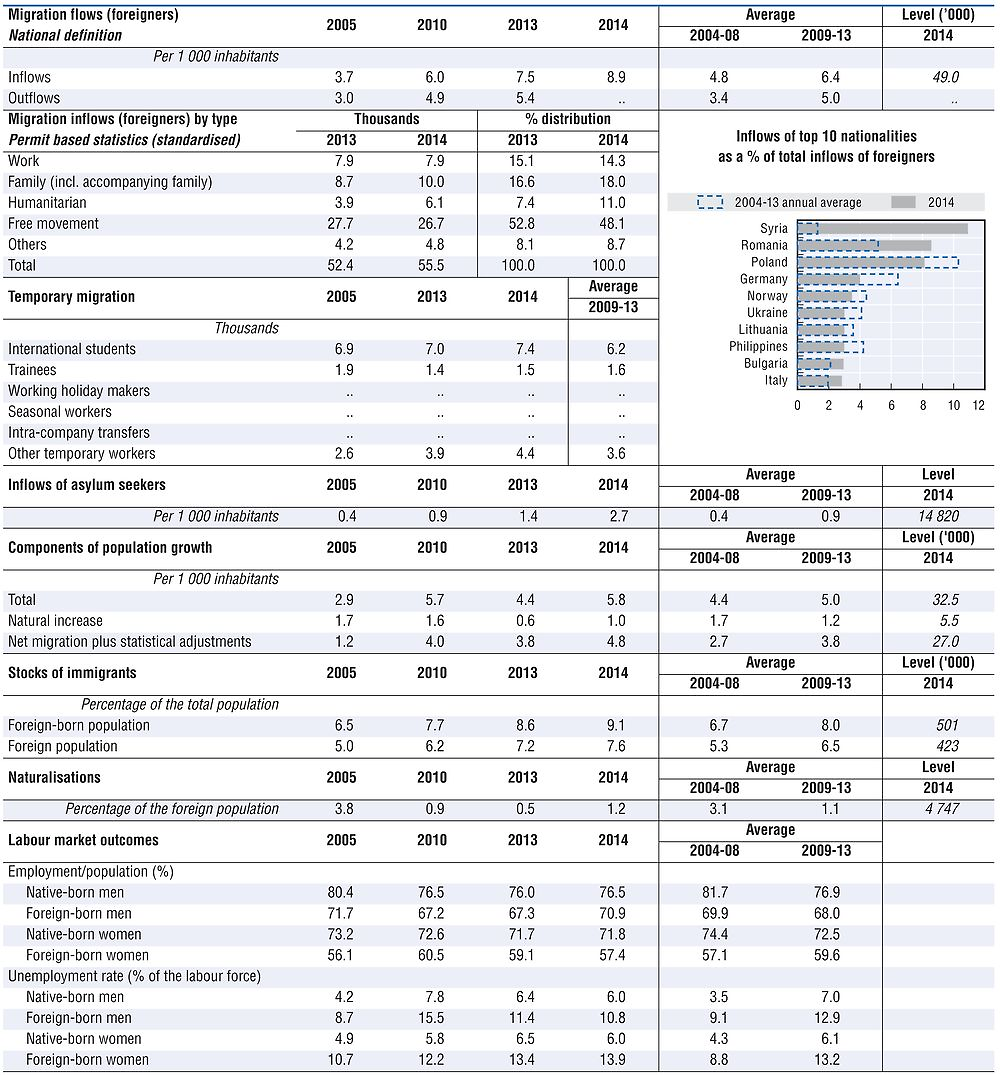Denmark
The migration inflow to Denmark has been increasing continuously since 2009, reaching 97 900 persons in 2015 (+13% over 2014), according to Statistics Denmark. The number of Danish citizens in the migration inflow basically remained constant at around 22 000. Among the foreigners immigrating in 2015, the largest groups were nationals of Syria (11 300, +109% over 2014), Romania (5 100, -1%) and Poland (4 800, -3%). The migration outflow plateaued at 49 000, of whom 20 500 were Danish citizens. The net migration inflow has been increasing by more than 25% each year since 2013, mainly due to the increase in the inflows of foreigners.
There were 540 000 immigrants residing in Denmark in January 2016 (defined as persons whose parents are both foreign citizens or were both born abroad). This number was 8% higher than one year earlier. Poland remained the immigrants’ main country of origin (+7% compared to 2014), followed by Turkey (+0.4%), Germany (+1.4%), Syria (+108%) and Romania (+17%). The share of immigrants in the country’s entire population grew from 8.9% in January 2015 to 9.5% in January 2016.
A total of 84 700 residence permits were issued in 2015, 17% more than in 2014 (72 300). EU/EEA nationals accounted for almost half of all permits over the past years. Other new permits (issued to third-country nationals) were relatively evenly distributed among the four main grounds (family, employment, humanitarian and study). The number of permits on family grounds doubled to 11 600 in 2015, while those on humanitarian grounds increased by 80%. Twelve thousand residence permits for work purposes were issued to non-EEA nationals, mainly to nationals of India, China and Iran.
According to Eurostat data, there were 20 900 asylum applications in 2015 (including dependents). This number represented an increase of more than 43% compared with 2014. The top three countries of origin (Syria, Iran, Afghanistan) accounted for two-thirds of the total applications received. Around 81% of the decisions made at first instance were positive, compared with 51% in the EU28.
In February 2015, an amendment of the Aliens Act introduced a new temporary subsidiary protection status for refugees who are entitled to asylum due to a general situation in the home country.
With the reform of international recruitment that entered into force in January 2015, the green card scheme was targeted to support the need of enterprises for highly qualified labour. Increased focus was placed on educational levels, and the point system changed to match the demands of the Danish labour market. At the same time, conditions for researchers were improved, granting them more flexibility regarding their residence in Denmark. They may now reside outside the country for more than six months without losing their residence and work permit.
A new Ministry of Immigration, Integration and Housing was formed, and made responsible for all immigration and integration policies. Furthermore, in July 2015 the new government presented a bill introducing a lower integration allowance aimed at giving newly arrived refugees and immigrants a greater incentive to work and become integrated into Danish society. The integration allowance also applies to newly arrived refugees, immigrants as well as to Danish citizens who have not been resident in Denmark for the past seven out of eight years. The allowance, which also includes a language bonus, entered into force in September 2015.
Other proposed changes by the new government were new and flexible rules on family reunification, and more restrictive requirements for foreigners wishing to obtain permanent residence and Danish nationality. A series of proposed measures would make it less attractive to seek asylum in Denmark; these include reintroduction of an integration potential criterion for selecting quota refugees, and stronger measures for checking the asylum seeker’s identity. Measures were also proposed to eliminate the possibility for refugees to obtain permanent residence without being able to speak Danish or being in employment. Subsequently the government announced its goal to reduce total spending on immigration by at least DKK 1 billion annually, and to reinforce aid to the refugees’ regions of origin.
In January 2016, the government adopted a bill to confiscate certain valuables from asylum seekers in order to help pay for the costs of processing and settlement.

